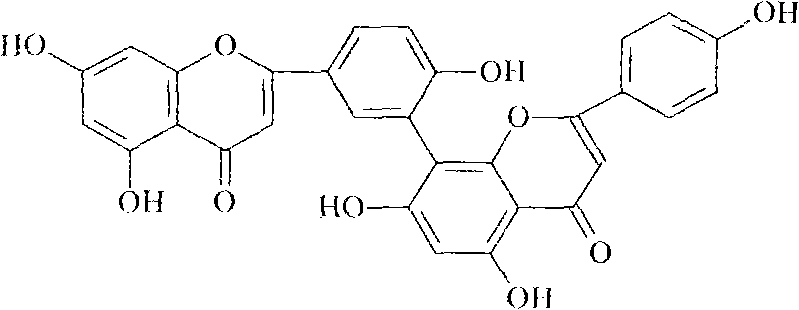Novel use of natural amentoflavone in curing viral diseases
A technology of biflavonoids and viral diseases, which is applied in the field of medicine and can solve problems such as no related reports.
- Summary
- Abstract
- Description
- Claims
- Application Information
AI Technical Summary
Problems solved by technology
Method used
Image
Examples
Embodiment 1
[0012] Example 1: Inhibitory effect of amentoflavone on hepatitis B virus.
[0013] Materials and Methods
[0014] 1. In vitro cell model: HepG2 cells transfected with hepatitis B virus (HBV), namely HepG2 2.215 cells.
[0015] 2. MTT method was used to detect the toxicity of samples to cells.
[0016] 3. Enzyme-linked immunoassay (EIA) was used to detect the inhibitory effect of samples on HBsAg and HBeAg.
[0017] Experimental procedure
[0018] 1. Cytotoxicity detection of drugs
[0019] After HepG2 2.2.15 cells were cultured in a 96-well cell culture plate for 48 hours, different concentrations of drug-containing culture medium were added, and the culture was continued for 9 days (the medium was changed once every 3 days). 2.2.15 Toxic concentration of cells.
[0020] 2. Detection of inhibitory effect of drugs on HBV virus antigen
[0021] After HepG2 2.2.15 cells were cultured in a 96-well cell culture plate for 48 hours, a series of drug-containing culture solution...
Embodiment 2
[0024] Example 2: Materials and methods for the detection of herpes virus inhibitory activity of amentoflavone in vitro
[0025] 1. In vitro host cells: Vero cells.
[0026] 2. Virus strain: herpes simplex virus type I (HSV-I).
[0027] 3. CPE method to detect the toxicity of drugs to cells.
[0028] 4. CPE method (cytopathic) to detect the inhibitory effect of drugs on herpes virus.
[0029] Antiviral test process
[0030] 1. Cytotoxicity detection of drugs
[0031] After Vero cells were cultured in a 96-well cell culture plate to form a monolayer, drug solutions of different concentrations were added and cultured for 3 days, and the toxicity of drugs to Vero cells was detected by CPE method.
[0032] 2. Drug anti-herpes virus detection
[0033] After Vero cells were cultured in a 96-well cell culture plate to form a monolayer, the cells were infected with 10TCID50 of HSV-I, and then a series of drug-containing culture solutions at non-toxic concentrations were added, an...
Embodiment 3
[0036] Example 3: Materials and methods for the detection of anti-influenza virus activity of amentoflavone in vitro
[0037] 1. In vitro host cells: MDCK cells.
[0038] 2. Virus strain: Influenza virus type A (H1N1) (A3 / Jingke / 30 / 95).
[0039] 3. CPE method to detect the toxicity of drugs to cells.
[0040] 4. CPE method (cytopathic) to detect the inhibitory effect of drugs on influenza virus.
[0041] Experimental procedure
[0042] 1. Cytotoxicity detection of drugs
[0043] After MDCK cells were cultured in a 96-well cell culture plate to form a monolayer, different concentrations of drug solutions were added, and the culture was continued for 3 days. The toxicity of drugs to MDCK cells was detected by CPE method.
[0044] 2. Drug anti-influenza virus detection
[0045] After the MDCK cells were cultured in a 96-well cell culture plate to form a monolayer, the cells were infected with 100 TCID50 of influenza virus, and then a series of drug-containing culture medium at...
PUM
 Login to View More
Login to View More Abstract
Description
Claims
Application Information
 Login to View More
Login to View More - R&D
- Intellectual Property
- Life Sciences
- Materials
- Tech Scout
- Unparalleled Data Quality
- Higher Quality Content
- 60% Fewer Hallucinations
Browse by: Latest US Patents, China's latest patents, Technical Efficacy Thesaurus, Application Domain, Technology Topic, Popular Technical Reports.
© 2025 PatSnap. All rights reserved.Legal|Privacy policy|Modern Slavery Act Transparency Statement|Sitemap|About US| Contact US: help@patsnap.com

